The increased expression of integrin α6 (ITGA6) enhances drug resistance in EVI1(high) leukemia
- PMID: 22295105
- PMCID: PMC3266272
- DOI: 10.1371/journal.pone.0030706
The increased expression of integrin α6 (ITGA6) enhances drug resistance in EVI1(high) leukemia
Abstract
Ecotropic viral integration site-1 (EVI1) is one of the candidate oncogenes for human acute myeloid leukemia (AML) with chromosomal alterations at 3q26. High EVI1 expression (EVI1(high)) is a risk factor for AML with poor outcome. Using DNA microarray analysis, we previously identified that integrin α6 (ITGA6) was upregulated over 10-fold in EVI1(high) leukemia cells. In this study, we determined whether the increased expression of ITGA6 is associated with drug-resistance and increased cell adhesion, resulting in poor prognosis. To this end, we first confirmed the expression pattern of a series of integrin genes using semi-quantitative PCR and fluorescence-activated cell sorter (FACS) analysis and determined the cell adhesion ability in EVI1(high) leukemia cells. We found that the adhesion ability of EVI1(high) leukemia cells to laminin increased with the increased expression of ITGA6 and integrin β4 (ITGB4). The introduction of small-hairpin RNA against EVI1 (shEVI1) into EVI1(high) leukemia cells reduced the cell adhesion ability and downregulated the expression of ITGA6 and ITGB4. In addition, the overexpression of EVI1 in EVI1(low) leukemia cells enhanced their cell adhesion ability and increased the expression of ITGA6 and ITGB4. In a subsequent experiment, the introduction of shRNA against ITGA6 or ITGB4 into EVI1(high) AML cells downregulated their cell adhesion ability; however, the EVI1(high) AML cells transfected with shRNA against ITGA6 could not be maintained in culture. Moreover, treating EVI1(high) leukemia cells with neutralizing antibodies against ITGA6 or ITGB4 resulted in an enhanced responsiveness to anti-cancer drugs and a reduction of their cell adhesion ability. The expression of ITGA6 is significantly elevated in cells from relapsed and EVI1(high) AML cases; therefore, ITGA6 might represent an important therapeutic target for both refractory and EVI1(high) AML.
Conflict of interest statement
Figures
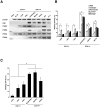
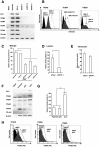
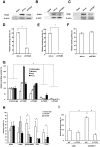

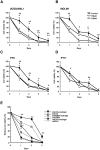
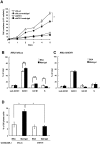
Similar articles
-
Induction of the proapoptotic tumor suppressor gene Cell Adhesion Molecule 1 by chemotherapeutic agents is repressed in therapy resistant acute myeloid leukemia.Mol Carcinog. 2015 Dec;54(12):1815-9. doi: 10.1002/mc.22252. Epub 2014 Dec 9. Mol Carcinog. 2015. PMID: 25491945
-
Integrin α6 and integrin β4 in exosomes promote lung metastasis of colorectal cancer.J Cancer Res Ther. 2024 Dec 1;20(7):2082-2093. doi: 10.4103/jcrt.jcrt_230_24. Epub 2025 Jan 10. J Cancer Res Ther. 2024. PMID: 39792419
-
Angiopoietin1 contributes to the maintenance of cell quiescence in EVI1(high) leukemia cells.Biochem Biophys Res Commun. 2011 Dec 16;416(3-4):239-45. doi: 10.1016/j.bbrc.2011.10.061. Epub 2011 Oct 18. Biochem Biophys Res Commun. 2011. PMID: 22033412
-
Ecotropic viral integration site 1, stem cell self-renewal and leukemogenesis.Cancer Sci. 2012 Aug;103(8):1371-7. doi: 10.1111/j.1349-7006.2012.02303.x. Epub 2012 May 18. Cancer Sci. 2012. PMID: 22494115 Free PMC article. Review.
-
Review: Aberrant EVI1 expression in acute myeloid leukaemia.Br J Haematol. 2016 Mar;172(6):870-8. doi: 10.1111/bjh.13898. Epub 2016 Jan 5. Br J Haematol. 2016. PMID: 26729571 Review.
Cited by
-
PSMC2 is up-regulated in osteosarcoma and regulates osteosarcoma cell proliferation, apoptosis and migration.Oncotarget. 2017 Jan 3;8(1):933-953. doi: 10.18632/oncotarget.13511. Oncotarget. 2017. PMID: 27888613 Free PMC article.
-
Imbalanced expression of polycistronic miRNA in acute myeloid leukemia.Int J Hematol. 2017 Dec;106(6):811-819. doi: 10.1007/s12185-017-2314-1. Epub 2017 Aug 22. Int J Hematol. 2017. PMID: 28831750
-
CGRP-CRLR/RAMP1 signal is important for stress-induced hematopoiesis.Sci Rep. 2019 Jan 23;9(1):429. doi: 10.1038/s41598-018-36796-0. Sci Rep. 2019. PMID: 30674976 Free PMC article.
-
Integrin α6-Targeted Molecular Imaging of Central Nervous System Leukemia in Mice.Front Bioeng Biotechnol. 2022 Feb 23;10:812277. doi: 10.3389/fbioe.2022.812277. eCollection 2022. Front Bioeng Biotechnol. 2022. PMID: 35284414 Free PMC article.
-
Integrin α6 mediates the drug resistance of acute lymphoblastic B-cell leukemia.Blood. 2020 Jul 9;136(2):210-223. doi: 10.1182/blood.2019001417. Blood. 2020. PMID: 32219444 Free PMC article.
References
-
- Morishita K, Parker DS, Mucenski ML, Jenkins NA, Copeland NG, et al. Retroviral activation of a novel gene encoding a zinc finger protein in IL-3-dependent myeloid leukemia cell lines. Cell. 1988;54(6):831–840. - PubMed
-
- Morishita K, Parganas E, Bartholomew C, Sacchi N, Valentine MB, et al. The human Evi-1 gene is located on chromosome 3q24–q28 but is not rearranged in three cases of acute nonlymphocytic leukemias containing t(3;5)(q25;q34) translocations. Oncogene Res. 1990;5(3):221–231. - PubMed
-
- Barjesteh van Waalwijk van Doorn-Khosrovani S, Erpelinck C, van Putten WL, Valk PJ, van der Poel-van de Luytgaarde S, et al. High EVI1 expression predicts poor survival in acute myeloid leukemia: a study of 319 de novo AML patients. Blood. 2001;101(3):837–845. - PubMed
-
- Lugthart S, van Drunen E, van Norden Y, van Hoven A, Erpelinck CA, et al. High EVI1 levels predict adverse outcome in acute myeloid leukemia: prevalence of EVI1 over-expression and chromosome 3q26 abnormalities underestimated. Blood. 2008;111(8):4329–4337. - PubMed
Publication types
MeSH terms
Substances
LinkOut - more resources
Full Text Sources
Other Literature Sources
Medical
Research Materials
Miscellaneous

